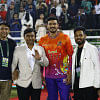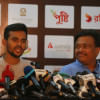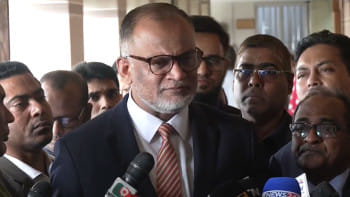Once a promising Test venue, now a complete wreck

The cricket fans of Khulna cannot remember the last time an international cricket match was held at the Sheikh Abu Naser Stadium (SANS) nor are they too optimistic about seeing one at the Rupsha-Bhairab shore any time soon.
All that keeps resurfacing on their memories are some pleasant moments that this venue stood witness to: Tamim Iqbal raising his arms to celebrate a phenomenal double century in a Herculean partnership with Imrul Kayes against Pakistan in the last Test match played here some nine years ago, just a year before this venue went out of bounds for international cricket; or when Shakib Al Hasan became only the third cricketer in history to take 10 wickets and score a century in the same Test; or when Bangladesh played their first Twenty20 match and won it; or when Bangladesh condemned the West Indies to one of their heaviest defeats in ODI cricket – a bit of a revenge one year after being bowled out by the Caribbeans for a paltry 58 in a World Cup match in Dhaka.

Despite witnessing some of the most historic moments in Bangladesh cricket, the life of SANS as an international venue has been a short one – hosting only 12 men's international matches and one women's international match from 2006 to 2016.
Situated in the Mujgunni area next to the Khulna-Jashore Highway, SANS started off on 13.80 acres of land, costing Tk 15 crore as one of five cricket stadiums built across the country to host the ICC Men's Under-19 World Cup in 2004. Gaining ODI hosting status in 2006, the stadium's capacity was increased from 15,000 to 20,000 in 2012 before it got approved as a Test venue.

Albeit hosting international matches intermittently, it seemed like SANS was on its way to becoming a regular fixture in Bangladesh's increasingly-busy international calendar. Instead it has been gathering dust for around eight years following a cyclone in mid-2016, has seen no renovation which is hastening its descent into obscurity.

It is not that the authorities do not realise the gravity of the issue, but what remains as the roadblock towards renovating the stadium is the red-tapism and back-and-forth between the National Sports Council (NSC), the owner of the stadium, and the Bangladesh Cricket Board (BCB), the users of the venue.
In the last eight years, NSC engineers have visited the venue many times. Many letters have been sent from the BCB to the NSC, but the fate of the stadium has remained unchanged.

During a recent visit to the stadium, this correspondent found the digital scoreboard smashed, floodlights tower covered with bushes and the dressing room for players unusable. The front glass of the president's box and several corporate boxes were broken, the sight screen was destroyed, the press box damaged.
Apart from these, the air conditioners, fans and other electrical devices installed in these boxes were out of order. The expensive furniture of the president's box was also on the verge of destruction. The plaster was coming off the walls, the tiles on the floor were cracked open and the toilets unusable.
Even a look at the gallery gave the vibe of a deserted place. The faded plastic chairs were so fragile that even a little bit of pressure was enough to break it into bits. Pieces of broken blue and green coloured chairs could be found in bird nests on nearby trees.

An official of the Khulna District Sports Association, who did not want to be named, claimed that the development and maintenance of the stadium were stalled due to the disagreement over the control of the stadium between the BCB and the NSC.
Dilip Barmon, a sports commentator at Bangladesh Betar (Radio Bangladesh) said that BCB and NSC are busy playing games over the renovation.
"BCB wants to completely refurbish this stadium while the NSC wants to repair it as part of routine work – making the situation complicated.
"At one time, BCB gave two reasons for not holding international matches in Khulna: there was no good hotel and there was a problem with communication. But now those problems have been solved. Padma Multipurpose Bridge has brought incredible change to the communication network between Dhaka and Khulna," he said.
Md. Mostafizur Rahman Rasel, the venue coordinator, acknowledged that the gradual deterioration of media centres due to non-use.
"All the infrastructural aspects of this stadium have been scrutinised and all the information has been sent to the NSC, which is working on preparing a DPP [Development Project Proposal],'' he said.
"There is no problem in conducting local cricket and training. Girls come here for practice but international matches are not possible if there is no renovation.
"However, I have heard that Tk 120 crore has been proposed to repair it. Although, no planning order on paper has arrived so far," he added.
Though the stadium was modernised in 2010 at a cost of Tk 64 crore, many people raised questions regarding the quality of work done by Parisha Enterprises and Ellora Trading.
SM Mortaza Rashidi Dara, general secretary of Khulna Divisional Sports Association, acknowledged the stadium's current status and emphasised on its use for various domestic matches despite the absence of international matches.
He said that for the renovation of the gallery, tenders have been invited through the NSC and sent to the Ministry of Youth and Sports.
"To bring international cricket back, the old infrastructure of this stadium will have to be demolished and rebuilt, which is a major project requiring a long process," he opined.
But time is of the essence to the BCB, especially as Bangladesh cricket suffers from a dearth of venues. BCB's Grounds Committee Chairman Mahbub Anam is all for renovation and feels the sooner the renovation takes place the better.
"We hope that these stadiums [that are left neglected] will be made available for use again after renovations and improvements are done by the NSC, especially for our cricket as we are in desperate need of stadiums," Anam told The Daily Star.
It is a sorry state of affairs that the only international stadium from a division that has produced some of the most influential cricketers of the country, including Habibul Bashar, Mashrafe Bin Mortaza, Shakib Al Hasan, Anamul Haque, Imrul Kayes, Tushar Imran, Soumya Sarkar, Mustafizur Rahman and many more, continues to be neglected. It is high time the NSC and the BCB reached a consensus and brought international cricket back to the people of the southwestern region.

 For all latest news, follow The Daily Star's Google News channel.
For all latest news, follow The Daily Star's Google News channel. 








Comments